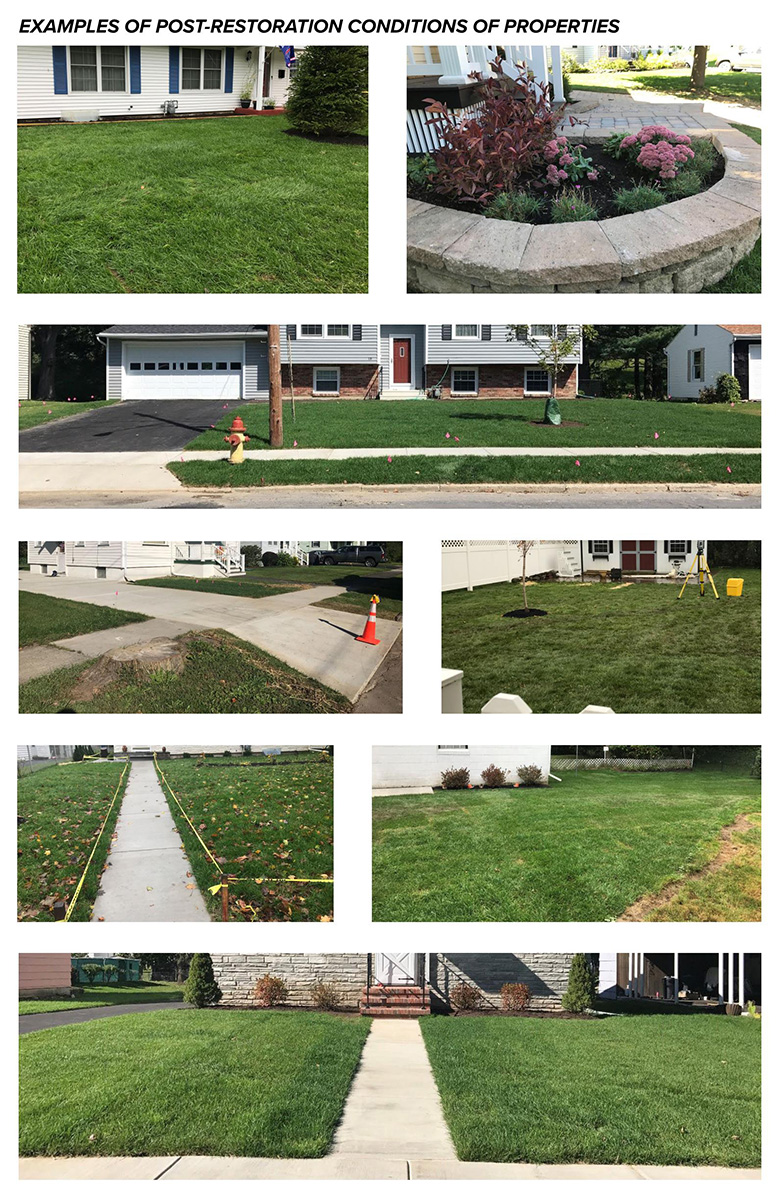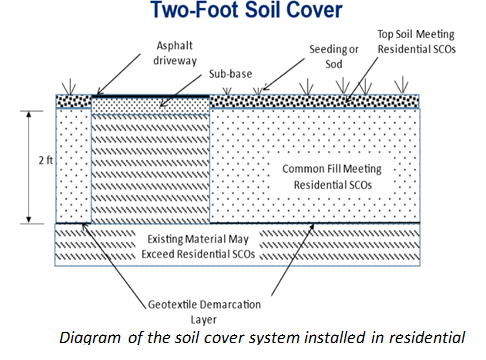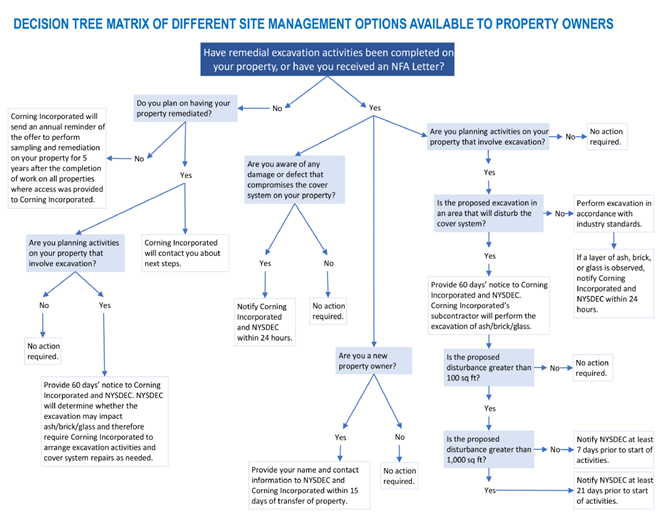This is the last phase of remediation, where subject material remains above unrestricted standards, and it begins with the completion of construction activities.
Interim Site Management Plan (ISMP)
The ISMP is intended to address all soil management issues until the remedy is fully implemented and will terminate once all properties where access was granted are remediated and a Department-approved SMP is in place. In July 2020, an ISMP was established for OU3 (with the exception of Section 1.6 Notifications which remains in draft form). The ISMP defines the inspection, reporting, and investigation requirements for OU3 and includes procedures for handling and disposing of contaminated material. If Subject Material is encountered during a capital improvement project, Corning Incorporated Corning-Painted Post School District, Corning Christian Academy, and the City of Corning must adhere to the ISMP and the Excavation Work Plan (Appendix B) to ensure public and worker safety during the investigation, delineation, removal, and restoration efforts. Furthermore, this ISMP will ensure a cover system is in place to prevent contact with subject material. For the Study Area, an ISMP is required during pre-design, design and remedial activities that are consistent with site management for properties (including rights of way and utility corridors). An ISMP for OU1, 2, and 5 was established in February 2019 (with the exception of Section 1.6 Notifications and Appendix B Section 2 Notifications, which remain in draft form).

Site Management Plan (SMP)
For the Study Area, an SMP will be submitted in order to manage subject material remaining at the site, and any engineering controls installed as part of the remedy. The document will include:
- An Institutional and Engineering Control Plan that identifies all use restrictions and controls for the area of concern, and details the steps and requirements to ensure the following institutional and/or engineering controls remain in place and effective. It requires Corning Incorporated to submit to DEC periodic reviews and certification of institutional and engineering controls.
- Institutional Controls: Are a non-physical means of enforcing a restriction on the use of property that restricts land use (residential, commercial, industrial), restricts the use of groundwater, or provides notice to the public of site management provisions which prevent interference with the effectiveness of a remedial program. An Environmental Easement is to be placed on the Corning Christian Academy, Corning Painted-Post High School and Memorial Stadium. ICs in OUs 1, 2 and 5 include any voluntary agreements between Corning Incorporated and property owners for access and provisions to enable the installation/maintenance of cover systems, management of remaining contamination, excavation, inspections, sampling, and/or any other requisite activities.
- Engineering Controls: Are any physical barriers to actively or passively contain, stabilize, restrict the movement of contamination, or eliminate potential exposure pathways. In the case of OUs 1, 2 and 5, a two-foot soil cover is required to allow for residential use of the property, and constitutes an engineering control. The cover will consist either of the structures such as buildings, pavement, sidewalks, etc., or a soil cover in areas where soils which exceed the applicable soil cleanup objectives (SCOs) or target fill (will remain below two feet). In the case of the CPP High School, a one-foot cover is required.
- A Monitoring Plan to assess the performance and effectiveness of the remedy. The plan includes, but may not be limited to:
- monitoring of groundwater to assess the performance and effectiveness of the remedy
- a schedule of monitoring and frequency of submittals to DEC
- an annual visual inspection of properties to ensure that controls remain in place and effective
- An Excavation Plan, which details the provisions for the management of future excavations, including a provision to allow a homeowner to dispose of inconsequential amounts of ash, brick and glass in household garbage.
- Assessments of effectiveness and protectiveness of the remedy.
- The Site Management Plan also includes provisions, such as
- Further investigation to refine the nature and extent of contamination/remediation in areas where access has not been previously granted, and on properties where future excavations occur at depths greater than that remediated under the selected remedy or where unexpected target fill is encountered regardless of depth.
- Management and inspection of the identified engineering controls, including within right-of-way areas.
- Tracking property ownership changes to allow for continued communication with owners.
- Annual notifications and reminders from Corning Incorporated:
- To property owners, notifying of Corning Incorporated’s offer to implement the remedy for owners who decline remedy implementation/sampling for a period of five years after the completion of the work (on properties where access was provided to Corning Incorporated for investigation and/or remediation).
- To new property owners, notifying of Corning Incorporated’s offer to implement the remedy for new owners for a period of two years following the change in ownership. This provision to notify new property owners will run for a period of fifteen years after the completion of the work on all properties where access was provided to Corning Incorporated for investigation and/or remediation.
- To property owners with post-remedy remaining soil contamination (a reminder of the presence of such remaining contamination and of Corning Incorporated’s commitment to handling remaining contaminated soils, as necessary and in accordance with the intended use of the property).
- To the City and Town of Corning Code Enforcement Offices and Departments of Planning and Economic Development (a reminder to inform Corning Incorporated of building permits/approvals granted for properties within the area where contamination remains post remedy).
- To the City of Corning, Town of Corning, and/or Steuben County (a reminder to inform Corning Incorporated of any City/County plans to conduct soil disturbance work).
What Site Management Means for the Property Owner
A property owner is requested to notify DEC and Corning Incorporated of activities that may involve contact with ash, brick and/or glass materials.
By providing a 60-calendar day advance notice to Corning Incorporated and DEC of planned activities involving excavation, Corning Incorporated and DEC will have an opportunity to determine if the work may impact a cover system that was installed on the property or encounter ash, brick, and glass materials. The advance notification should describe the location and work to be performed, with the property owner’s planned schedule for the work.

The following flowchart depicts the different options available to property owners:

DEC recognizes that there are times when advance notice is not practical and a property owner is requested to notify DEC and Corning Incorporated for activities that had contact with a cover system that was installed on the property or with ash, brick, and glass materials as soon as the property owner can. DEC and/or Corning Incorporated will provide a written response on the next steps and any additional requirements pursuant to the Site Management Plan.
- Work Involving Building Permits: The property owner is requested to provide copies of building permit applications and building permits to DEC and Corning Incorporated for work in the Study Area in order for Corning Incorporated and DEC to have an opportunity to determine if the work may impact a cover system which was installed on the property or encounter known ash, brick and glass materials. The property owner is requested to notify DEC and Corning Incorporated of any planned activities that include excavations deeper than 2 feet in the Study Area.
- Property Transfers: The current property owner is requested to notify Corning Incorporated and the NYSDEC of any impending change in ownership of the property (identifying the tax map numbers in any correspondence), and to provide contact information for the new property owner. For properties which have not been remediated, Corning Incorporated will provide an annual notification to new owners of Corning Incorporated's offer to implement the remedy for new owners for a period of two years following the change in ownership.
- Unexpected Situations: The property owner is requested to notify Corning Incorporated and DEC within 24-hours of any situation (e.g. storm damage, settlement, animal burrowing, etc.) that compromises the effectiveness of the cover system or exposes ash, brick, or glass materials.
- Tree Preservation: Due to recent inquiries, DEC wants to remind property owners that a tree preservation plan was prepared for the Study Area. This document can be reviewed by the property owner and used during discussions regarding remedial activities on their property. The following link online to the Tree Preservation Plan describes the general approach for the protection and/or the removal and replacement of trees located within or near delineated remediation boundaries: https://www.dec.ny.gov/data/DecDocs/851046/.
Post-Restoration Inquiries
One of DEC’s top priorities is also ensuring that community members do not encounter any site-related contamination. The DEC is working with the DOH to determine the appropriate approach and program (or programs) to investigate and clean up other properties contaminated with fill containing glass, ash, and/or brick which are outside of the defined Study Area. The DEC will keep the public informed as additional investigation and cleanups are planned, with newsletters such as this one. The DEC will continue to evaluate any additional locations of possible historic waste disposal as we become aware of them to ensure the protection of public health and the environment.
Issues encountered by property owners that could be related to remedial activities include:
- Water infiltration in basements and/or new mold blooms: If property owners previously have not had an issue with water infiltration into their houses, but are now experiencing water infiltration that they believe is a result of remedial activities, they should contact the DEC and/or DOH immediately. Exposure to building dampness and dampness-related agents, including mold, has been recognized nationally and at the state and local level as a potential public health problem. Indoor mold exposure causes upper and lower respiratory health effects. Asthma and other allergic respiratory diseases can be also exacerbated by mold exposures.
- Property water ponding: On properties where removals have taken place, all disturbed areas are being regraded. It is possible that after regrading newly placed soils can settle potentially causing ponding or redirection of runoff towards structures. Settling and ponding of water could potentially lead to water infiltration into basements or impact the reestablishment of vegetation.
- Garden/yard restoration and vegetation establishment: The remedial teams continue to work closely with property owners to discuss all details regarding the property remediation and outdoor restoration prior to the start of activities. Following backfilling and restoration activities, an inspection will be performed with the property owner, the DEC representatives, and Corning Incorporated representatives to identify any outstanding issues to be addressed prior to demobilization from the property. In the unlikely event that the restoration plantings fail due to installation issues, further inspections can be arranged to assess causes and potential solutions.
Sod and plantings maintenance: Property restoration activities often include the installation of sod and various plantings. Sod is essentially already mature grass (lawn) that is placed in small squares or strips in a yard. It is recommended that lawn mowing begin as needed following notification from Corning Incorporated that maintenance of your lawn by Corning Incorporated’s contractor is complete (at that time, the lawn should be fairly well rooted and able to withstand normal wear and tear). The optimum lawn height for sod is 3.5 inches, and watering should be avoided 24-36h prior to mowing. Furthermore, it is suggested that the lawn, shrubs, and trees be watered about two times per week and more regularly during any period of extreme heat (daytime temperatures in excess of 90 degrees Fahrenheit), applying generally about 1 inch of water in total each week (this should include any natural rainfall). Finally, it is recommended to consider applying a balanced turf fertilizer to established sod (following the label instructions carefully) with a nutrient ratio of 3.75:0:1, which indicates the amount of nitrogen, phosphorus and potassium (NPK) content. It is also recommended that the fertilizer be applied using a rotary spreader (versus a drop spreader), and to avoid applying herbicides during hot and dry weather (only if necessary, these should be applied in cooler weather).

